Well, we’ve come full circle. What started with the Beta Quadrant and Alpha Quadrant, then continued more recently with the Gamma Quadrant. Now we’re at the final slice of the Milky Way Galaxy, the Delta Quadrant Sourcebook and what a finish. Folks, if you like Voyager and/or Borg then you are in for a treat. If you just want new ideas, fresh stats, and innovative mechanics then read on as well. Come for a ride and see just how far this thing goes.
This post originally appeared on my site Mephit James’ Blog.
The introduction to this book lays out the goal of the Delta Quadrant Sourcebook succinctly. “This supplement covers everything you’ll need to play a game of Star Trek Adventures in the far-flung reaches of the Delta Quadrant.” Full stop. Sure you can bring those elements back to Federation space or you can have one-off encounters with the Hirogen or Vaadwaur, but primarily this is a book for campaigns set in the Delta Quadrant.
As with the Alpha Quadrant Sourcebook and the Gamma Quadrant Sourcebook, this book outlines new areas and options for Star Trek Adventures and it also advances the timeline of the game. The core rulebook started with a default year of 2371, around the events of Star Trek Generations and just before the start of Star Trek: Voyager. The Alpha Quadrant book moved that to 2372, the time just before the Dominion War started when the Federation and Klingons were clashing. The Gamma Quadrant book moved it even farther to 2374 when the Dominion War was at its peak, at the most desperate moments of Star Trek: Deep Space Nine. This supplement advances things further yet to the 2379 (nearly a decade after the core book) which puts it after the series run of Voyager and also after Star Trek: Nemesis (the latest point in the canon timeline until Star Trek: Picard).
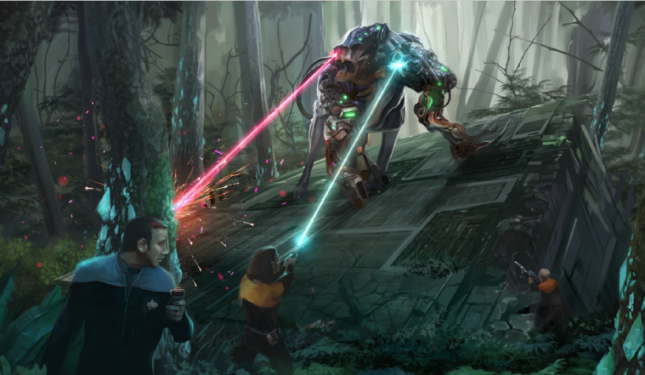
All of this is to say that the elements in this book require a pretty advanced time period for your game. For many, this isn’t going to be a problem. All of the games that I’ve played in have been set after the 2370s anyways and a good proportion of players are in the Star Trek Online era. However, a large fraction of home games likely follow the events of the Living Campaign and are already underway using the default year of the core rulebook. As such, the main focus in this book is a Starfleet vessel somehow ending up in the Delta Quadrant like Voyager was contending with the same sort of issues as on that series. Not a bad focus but one to keep in mind.
The Delta Quadrant
After the Introduction chapter comes the largest chapter in the book, an overview of political forces and major regions of the Delta Quadrant. This could otherwise be known as “a summary of Voyager antagonists” but as with the Tzenkethi in the Alpha Quadrant and the Dominion in the Gamma Quadrant, there ar a lot of blank spots filled in with this sourcebook. I particularly like the tone of this chapter which is written as a briefing for Starfleet captains on the political situation in the Delta Quadrant, a fun way to hide plot hooks.
First up in this alphabetical line-up is the Devore Imperium, a xenophobic militocracy that particularly hates telepaths, which was seen in Voyager’s sixth season. Next comes the Haakonian Order, the force that devastated Neelix’s people, and the hidden Hierarchy, who watch from afar and unfortunately get no real species name here. There are, of course, the Hirogens who hunt anything they find, and the Kazon, who form sects around strongman dictators, together probably Star Trek: Voyager’s most memorable villains. The Krenim Imperium (a would-be temporal power) and Malon Cooperative (awash in their own radioactive waste) were both an “oh yeah them” moment for me, while Species-8472 needs little introduction (but gets a full, dense page).
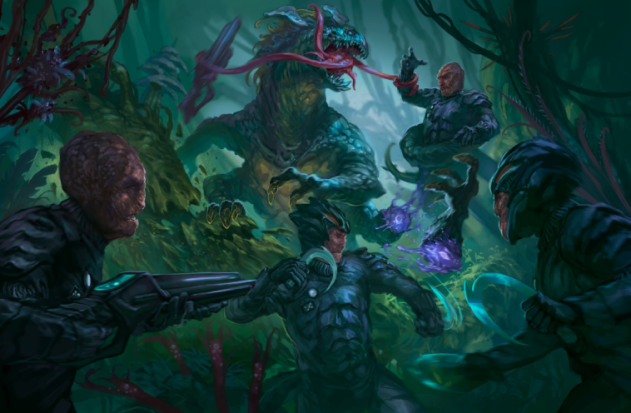
The Srivani, a medically-focused species with phase variance cloaking technology, I have no memory of but really want to go back and watch now, likewise with the xenophobic and mysterious Swarm. Everyone knows the Talaxians thanks to Voyager’s Mr. Neelix, and the resurrected Vaadwaur Imperium will be familiar to Voyager fans and players of Star Trek Online alike. I still can’t think of the diseased Vidiian Sodality without shuddering and the Voth have always been appealing due to my well-established love of dinosaurs.
With all of this in mind, it’s worth jumping back to the Introduction chapter again to point out that there’s a “Yesterday’s Enterprise” sidebar (one of my favorite features of this game) which gives you ideas for using the Delta Quadrant in earlier eras. This page offers a brief overview of Delta Quadrant history, starting with the migration of the Voth before the Star Trek: Enterprise era, through the enslavement of the Kazon by the Trabe during the events of Enterprise, and then a few lost missions to the Delta Quadrant during the original series. All of this can provide fodder for GMs in earlier era wanting to pepper this book’s material into their campaigns.
The chapter continues with some stellar and spatial phenomena encountered by the U.S.S. Voyager on its journey: graviton ellipses, trimetric fractures, chaotic space, the Nekrit Expanse, the Vaadwaur’s Underspace, Omega Molecules, subspace voids, and (of course) fluidic space. There’s also a brief survey of Delta Quadrant worlds (each getting about a quarter of a page) with Avery III, the Demon Planet where the silver bloods live, Banea, Drayan II, Enara Prime, the “Weird Planet Diplaced in Time,” Hemikek IV, that planet where they found Amelia Earhart in that one episode, Malon Prime, the Monean Waters, Ocampa V, the planet fought over by the Kradin and Vori, Quarra, Sikaris III (the most tragic of Easter eggs now), Takar II, Talax, Taresia, Uxal VI (home to radiation sickness thanks to an ancient Earth probe), and Vaadwaur Prime.
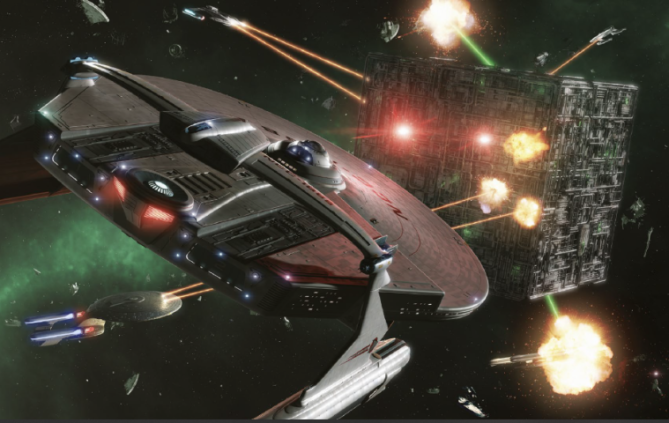
The Borg
Let’s stop beating around the bush here. There are many different threats in the Delta Quadrant but the biggest one is the Borg. As the book puts it, “the single greatest threat the Federation has ever encountered, the Borg are a relentless foe which has existed for thousands of years. While its origins remain a mystery, the Collective has established one of the largest territories within the Galaxy.” I’d go farther to say that they have the largest territory in Star Trek canon: much larger than the Federation or even the Dominion. They are a blackened cancer on the galaxy and they are growing.
The Borg represent one of the easiest ways to bring Delta Quadrant elements to your Star Trek Adventures game in the Alpha and Beta Quadrants. The twenty-five page section on the Borg Collective is part of the second chapter along with the parts discussed above, but since it’s so very large and the Borg are so very important to the Star Trek narrative we’re going to give it more attention too.
Of course, the Borg are already discussed in the core rulebook so what new stuff is offered here? Well, there’s three pages of material that details the design and function of the Collective to detail the Borg a little more (as Star Trek: Voyager did), plus five sidebars with messages from various groups on their encounters with the Borg (from Starfleet, the Romulan Star Empire, the Cardassian Central Command, the Obsidian Order, and a Talaxian trader). There’s a section on “Resisting a Force of Nature” (i.e. how to combat the Borg), another on their ships and technology, a full-page after action report on the tragic Battle of Wolf 359, some perspective on life in the Collective and the types of drones that make it up, and a short section on life as a disconnected or “liberated” Borg drone.
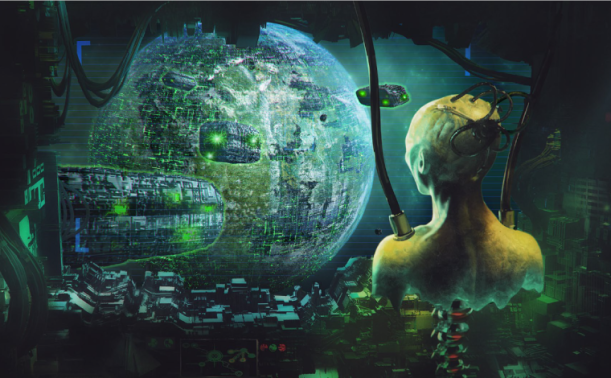
The next subsection covers Borg worlds. They are famous for their transwarp hubs and floating Unimatrix constructs but they also build on worlds that provide valuable resources and solid ground to set up their facilities. As an avid player of Star Trek Ascendancy the idea of Borg worlds fill me with dread, but this is some awesome information that can provide roleplaying opportunities. Terrestrial worlds, gaseous planets, Class-Y “demon” planets, and asteroid habitats are all detailed with Traits and mechanics (some of which could be used for non-Borg situations) and then those massive Unicomplex structures get the same treatment. If you can only think of encounters with the Borg as cubes attacking and boarding starships, read through this section and you might never think of that type of encounter again.
Species of the Delta Quadrant
So far we’ve gotten a lot of setting information on the Delta Quadrants, but starting with this chapter we start to get the crunch. Obviously, Delta Quadrant species have the same sort of problem as Gamma Quadrant species when it comes to a campaign based on a Starfleet crew. It’s easy to see how these could become new NPCs for your campaign but as PCs they would be unique members of Starfleet to say the least. Without something like the Bajoran wormhole, though, such a character would likely need to be carried by Voyager and if that happened then why didn’t we see it? Instead, maybe they were flung into the Alpha Quadrant by a Caretaker or wandered through a semi-stable Barzan wormhole. They might also be recovered Borg, which we’ll get to in a bit.
First off we have the resource Ankari and their alternative FTL technology, the organized Jye administrators, the Lokirrim who are master holographers (but in a war against “photonic insurgents”), the empathic and intrusive Mari, the aquatic and nomadic Moneans, the physically imposing Pendari, the peaceful and storytelling Sikarians, the familiar and endearing Talaxians, the possessive Turei who use the Underspace tunnels of the Vaadwaur, and the welcoming Zahl.
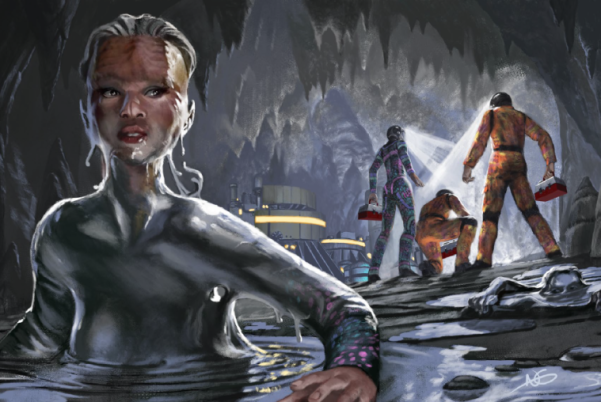
Liberated Borg, like Seven-of-Nine or Hugh (in his Star Trek: Picard version), are a really amazing option that could easily spiral out with GMs who aren’t careful. Like a hybrid character you have the Liberated Borg Trait and also the Trait of another species, the one you were born as. There are only two Talents for this species but one of them expands into a ton of options. Borg Neural Interface allows them to work more easily with computers and Borg Implants allows them to choose 1-3 implants from a sidebar. It’s up to the player how many they gain, but each implant adds +1 to the Difficulty of Medicine checks to treat the character and to the Complication range of social interaction Tasks. For some players this is too high a price but for others the opportunity to have a cybernetic arm built for engineering, stronger stamina, Resistance from exo-plating, or even adaptive shielding… Well every roleplayer is familiar with the idea of a “dump stat” so it’s not impossible to imagine going all out with a blunt, scarred character who has amazing implants. The built-in drawbacks are already a way to balance that but GMs should also be prepared to play up the Borg Trait and other complexities from their cybernetic existence.
We saw the stats for Liberated Borg in the Voyager Player Characters and that was also the introduction of the Ocampa stats. These, though, were the only part of those Player Characters that I disliked because the psionic abilities of Kes were just off the charts, and not in a good way. I don’t mind powerful abilities but they were also not very well defined. In the Delta Quadrant Supplement, though, we get unevolved Ocampa. This is fine but I’m still hoping for some fixed abilities for the sort of psionic powerhouse that Kes eventually became. Maybe I’ll have to write them myself.Lastly, several species from Star Trek: Voyager work simply as Traits added to existing species. The Silverblood clones from a demon planet and the resurrected members of the Kobali that were once part of other species. Disconnected Borg is an interesting/terrifying option to have characters be just straight-up Borgs using stats from the core rulebook (or this sourcebook) and being cut off from the Collective. This would be Hugh from The Next Generation or Seven when she first joined the Voyager crew. I think this is really only a good option for NPCs but some GMs might like having players who are the most powerful characters in every single scene. You do you, I guess.
Next Time…
Next time we’ll be looking at the starships and adversaries of the Delta Qudrant. Hopefully you see the huge potential of this book and so next time we’ll look at the vast playground it offers too. I’ll cut to the chase and say that my Tribble Rating for this book is 5/5. It’s totally anchored in canon, very accessible and full of Easter eggs, likeable to imagine all of your favorite Delta species in an RPG context, accessible in terms of show materials and readability, and (of course) high quality as we’re used to from Modiphius,

Recently I’ve been talking to folks about the different faces of Star Trek. The original series, The Next Generation, Deep Space Nine, and Discovery all show Starfleet up against opposing forces. The idealism of the Federation is contrasted with the paranoia of the Romulans or the bravado of the Klingons. Something like Voyager or Star Trek: Picard, though, is Starfleet when no one’s watching. As the U.S.S. Voyager headed home it could have cut corners, ignored directives, and done what it pleased. It didn’t, though, which was a central theme of the show throughout its run.
If you want a chance to tempt your players with dishonor and shortcuts, then join us next time for a wide open quadrant of just that.

Excellent review, as always!